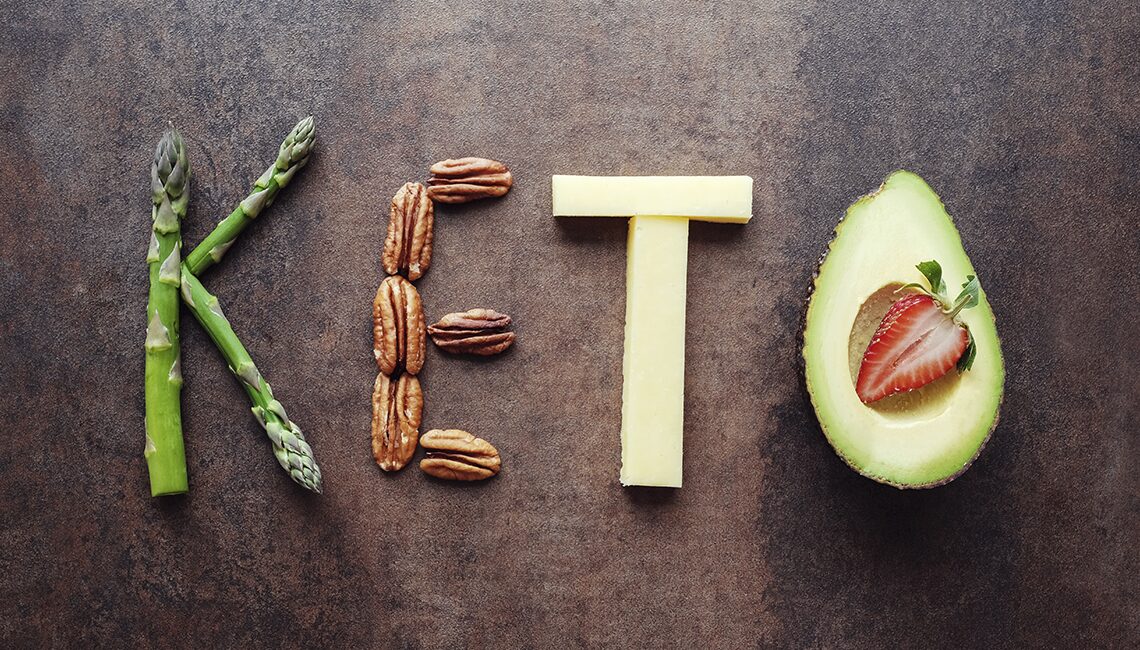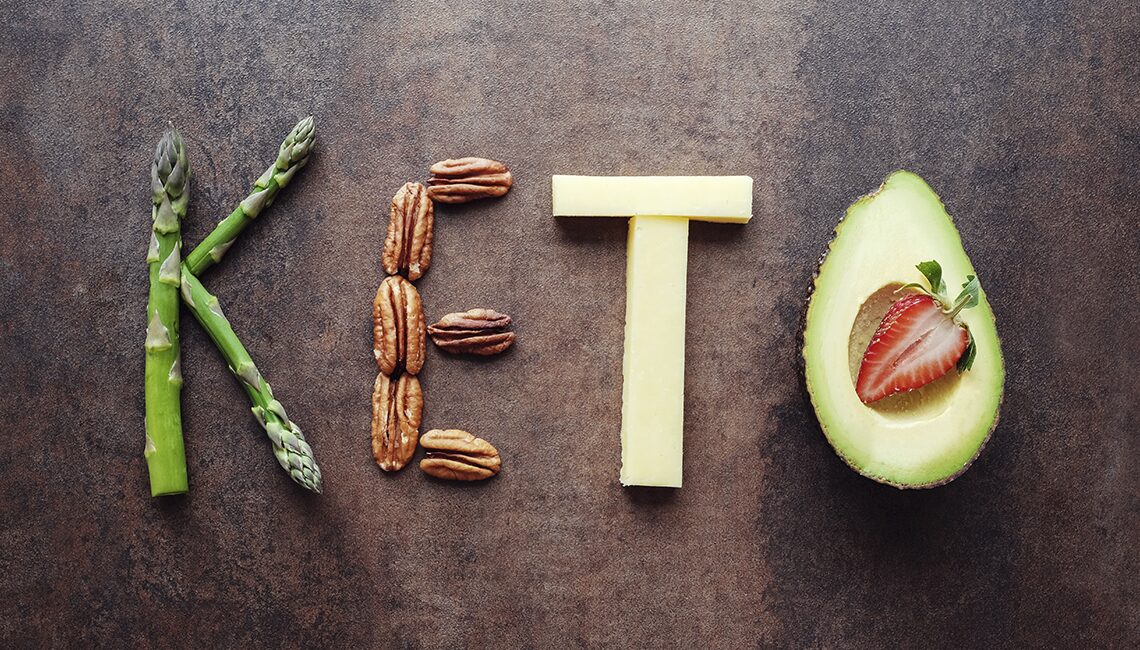If you are reading this, chances are you are one of estimated 45 million Americans that go on a diet every year. And this probably isn’t the first time you considered a different diet plan; most of us have tried over 100 diets in our lifetime. So, what is different about the ketogenic (or keto) diet?
For one thing, popularity. In 2020, “keto” was the most Googled food-related topic in the world, with 25.4 million searches (according to Bolst Global). But what does going keto mean anyway?
According to David Jockers, DMN author of Keto Metabolic Breakthrough, the keto diet is more than merely a fad, it is a lifestyle change. Most simply, a ketogenic diet involves limiting carbohydrates in your diet.
The most popular (and most studied) version, the standard ketogenic diet consists of:
- 70% calories from fat
- 20% calories from protein
- 10% calories from carbohydrate
The easiest way to translate this information into what is best for you is to use a keto calculator, which will tell you how much fat, protein, and carbs you should consume based on your current body weight, age, weight loss goals, activity level, and percentage body fat. One we like is www.betterme-keto-diet.com.
Ketogenic Goals
The goal of the ketogenic diet is to make your body use fat as its primary nutrition source. By drastically lowering the amount of carbohydrates in your diet, you place your body in a state of metabolism known as ketosis.
Ketosis is a normal, natural state that helps humans and animals survive when food is scarce. This is how animals that hibernate during the winter stay fed and healthy. During ketosis, your body burns fat instead of sugar, producing ketones. Ketones are a more efficient energy source than sugar.
This also means that your blood sugar levels are lower, which makes those spikes of high and low energy you may feel throughout the day even out. Many people feel like they have more energy on a keto diet and report that they feel better emotionally.
Ketones not only allow you to burn fat as fuel more efficiently, but they are also considered brain-protective, meaning they help prevent damage to brain cells and encourage the growth of neural pathways in the brain. This is way brain cells “communicate” with one another. The benefits of ketosis are far-reaching.
Benefits of the Keto Diet
Weight Loss
There is strong evidence that the keto diet can help you lose weight. As your body enters ketosis, it starts burning the fat reserves, which results in weight loss. Also, eating healthy fats makes you feel full, so you tend not to eat as much or as often. An analysis of 13 studies examining keto diets and weight loss showed that those on a ketogenic diet lost more than those on a low-fat diet. A recent study in Nutrition and Metabolism of 34 obese subjects showed that those on a keto diet lose almost five times more body fat than those on a low-fat diet after only two months.
Lowers Insulin Resistance
Insulin resistance is a hallmark sign of type II diabetes (non-insulin dependent) and is characterized by a failure of the cells in your body to respond to insulin. This leads to a rise in blood sugar levels, causing your body to store this excess sugar as fat. Studies show that ketogenic diets can help lower insulin resistance, as well as blood sugar levels.
Heart Health
Ketogenic diets have many positive effects on cardiovascular health. Studies show that ketogenic diets improve blood triglyceride levels. Additionally, when compared to a low-fat diet, ketogenic diets help increase HDL (“good cholesterol”) and decrease LDL (“bad cholesterol”) levels. Keto diets have also been shown to improve blood pressure values.
Brain Health
Ketones are neuroprotective, meaning they help protect the brain. Ketogenic diets have been used successfully in the treatment of epilepsy in children since the 1920’s. More studies are emerging demonstrating that ketogenic diets may help in reducing the symptoms as well as slowing the course of Alzheimer’s disease. One study showed that a ketogenic diet plays a role in minimizing the symptoms of Parkinson’s disease. Studies are also underway that suggest ketogenic diets have a positive effect on the symptoms associated with traumatic brain injury.
Polycystic Ovarian Syndrome (PCOS)
Polycystic Ovarian Syndrome, or PCOS is a hormonal disorder in women that affects menstrual cycles, fertility, weight gain, and insulin resistance. Preliminary research in Japan suggest that ketogenic diets improved menstrual cycles, reduced blood glucose levels, and resulted in weight loss.
Eating Keto
As mentioned earlier, a ketogenic diet is truly a lifestyle change. For most of us, this diet calls for drastic changes in our eating habits. This will require meal planning and most likely a pantry overhaul to ensure that you have the right foods available. The good news is that there a numerous websites, blogs, and books offering great keto recipes and tips for success. While there are many restrictions in terms of foods allowed, one good thing is that for the most part you do not have to focus on strict calorie counting like many other diet plans. And once you enter ketosis, you do not suffer the typical symptoms of weight loss like mood swings, sugar cravings, fatigue, etc. Listed below is a summary of the keto food’s dos and don’ts.
Keto Food Do’s
- Meat: red meat, chicken, turkey (grass-fed, pasture-raised)
- Seafood: shellfish, salmon, trout, tuna (wild caught)
- Eggs: cage-free, omega-3 when possible
- Leafy green vegetables: spinach, kale, cabbage, lettuces of any kind
- Low carb vegetables: broccoli, cauliflower, zucchini, spaghetti squash, tomato, asparagus, green beans, peppers
- Healthy fats: avocado, coconut oil, olive oil, butter, or ghee (made with grass-fed dairy)
- Fruit: strawberries, blueberries, raspberries, blackberries
- High-fat cheeses: cheddar, swiss, mozzarella, cream cheese, Colby, parmesan, etc.
- Nuts or Seeds: pecans, walnuts, almonds, pistachios, macadamia nuts, flaxseed, chia seeds, sunflower seeds, etc. (Nuts/seeds should be plain- no sugar coatings or flavorings)
- Sweeteners: stevia, monk fruit, erythritol (No sugar!)
- Shirataki noodles: low carb noodle containing glucomannan (fermented dietary fiber)
- Spices: salt, pepper, herbs, spices
- Coffee and Tea (unsweetened)
- Dark chocolate (100% cacao powder)
Keto Food Don’ts
- Grains: wheat, pasta, corn, rice, cereal, oats, oatmeal, grits, etc.
- Sugar and foods with high sugar content: soda, cookies, cakes, candy, ice cream, fruit juice, honey, maple syrup, anything containing high-fructose corn syrup
- Fruit: all fruits except berries
- Legumes: peas, black beans, garbanzo beans (chickpeas), kidney beans, etc.
- Root vegetables: carrots, potatoes, sweet potatoes, yams, parsnips
- Condiments: anything containing sugar or high-fructose corn syrup- ketchup, salad dressings, honey mustard, barbecue sauce, mayonnaise, etc.
- Processed vegetable oils: canola oil, corn oil, or anything that lists “hydrogenated” on the ingredient list
- Alcohol: beer, wine, liquor
- Fat-free or sugar-free diet foods
What to Expect While on the Keto Diet
Like most things worthwhile, success is a journey, not an overnight sensation. Before starting a ketogenic diet, or any diet for that matter, we at NEW YOU highly suggest you speak with your physician first. Ketogenic diets, while beneficial, are not for everyone, especially those who have kidney disease or are type I diabetic. Also, certain medications may not be compatible with a ketogenic diet.
So, you have made the decision to go keto- you cleaned out your pantry and made some meal plans. Now what? Typically, your body will start to enter initial ketosis in about two to three days…optimal ketosis (where the real fat burning happens) typically takes about two to three weeks. But how do you know you are in ketosis? Here are some signs and way to determine if your body is in ketosis.
Signs of Ketosis:
- More frequent urination- ketones are a diuretic (meaning more bathroom trips)
- Dry mouth
- Bad breath- you excrete ketones when in ketosis when you breathe, so you may notice a fruity odor to your breath, commonly called “keto breath”
- Decreased appetite- as you metabolize more fat than sugar, it is thought that your hunger hormones respond in your favor
- More energy and more mental focus- your brain utilizes ketones more efficiently than sugar. It is like putting higher octane fuel in your gas tank.
- Short-term fatigue- this is common, especially in the earlier stages
- Tiring easily during exercise- this is normal, especially when first removing carbs from your diet and your body will adapt over time.
- Digestive upset- Some people report issues with irregularity and diarrhea when first starting keto diets.
- Insomnia
- Testing for ketones: You can test for ketones using a blood ketone meter, a ketone breathalyzer, or ketone urine strips. Blood ketone meters are the most accurate; although it tends to get expensive due to the price of the ketone test strips, and you have to prick your finger every day. The breathalyzer is the most economical, but results can be skewed if you do not drink enough water, etc. Urine strips are the most used but are not the most reliable.
- “Keto flu”- characterized by headaches, dizziness, mental fog, nausea, and digestive issues that occurs within the first week of starting a ketogenic diet. This is temporary and goes away as your body gets used to the removal of sugar from your diet.
Tips for Success on the Ketogenic Diet
In addition to following the proper meal plans and macronutrient guidelines, there are other aspects to consider getting the most out of a ketogenic lifestyle change.
- Drink water (at least eight 8-ounce glasses per day)
- Consider combining intermittent fasting with the keto diet- Try using a scheduled 8-hour window for eating and then 16 hours off. For example, mealtime would be from 12noon-8pm and then no food until the next day.
- Cut the carbs- Carbohydrates are hidden in many packaged foods, which is why salad dressings, packaged condiments, etc. are a “don’t” on the keto diet.
- Watch the protein- Many people confuse the keto diet with the Atkins diet. Too much protein slows down the conversion to ketosis. Stick to the recommendations from the keto calculator.
- Don’t obsess about fat or its calories- Healthy fats are necessary to put your body in ketosis.
- Avoid snacking- Snacking throughout the day affects blood sugar.
- Exercise- Exercise is very important to help maximize the results of a ketogenic diet. Shoot for 20-30 minutes per day.
- Supplement with MCT (medium chain triglyceride) oil- MCT oil helps boost ketone levels in the body. Caprylic acid is an example of an MCT oil.
The Final Verdict
A ketogenic diet is an effective way to lose weight and get your body back to metabolizing food the way we were meant to- by using natural whole foods. Based on the evidence, keto diets provide many health benefits in addition to losing weight. Why not try going keto? You have nothing to lose….but the weight of course!












